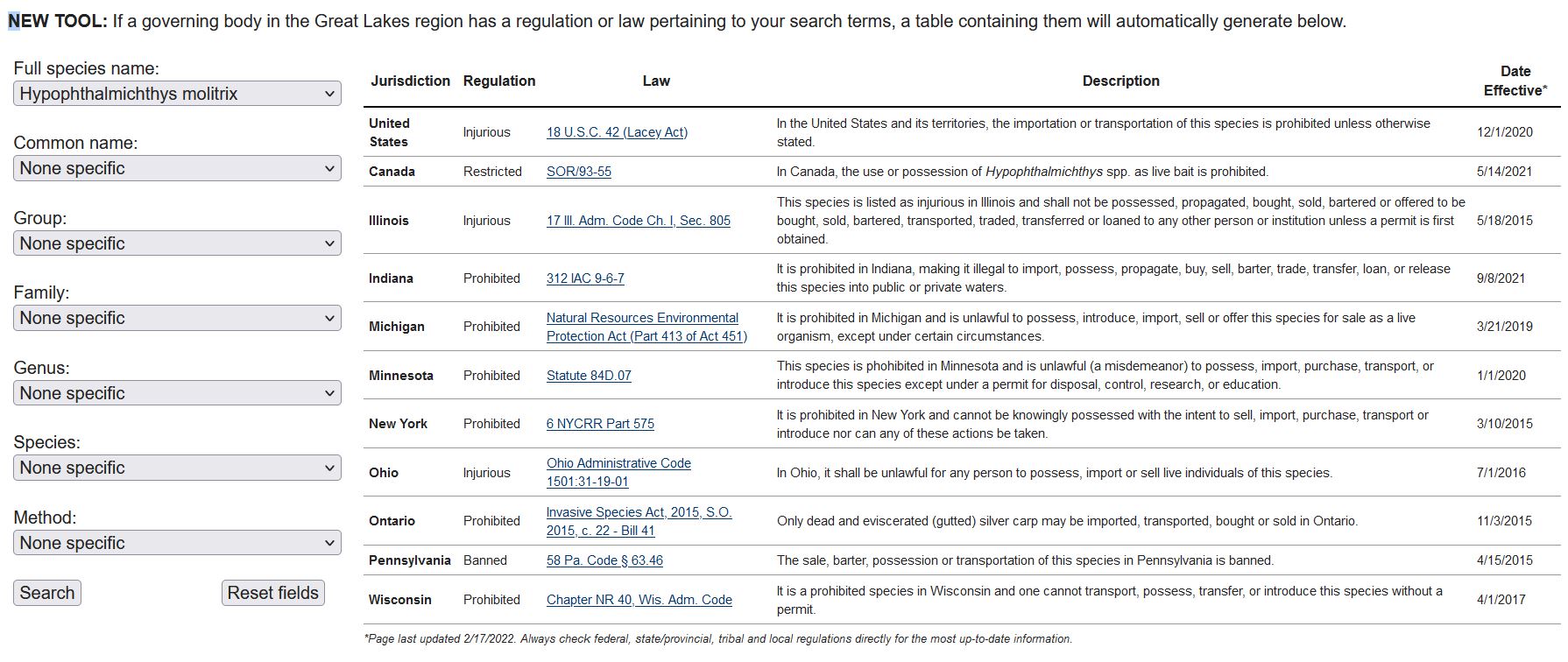New online tool keeps users up-to-date on AIS regulations
Regulations to protect the Great Lakes have broad impacts on entire states and countries. A new online tool displays the most up-to-date information on nonindigenous species regulation in the Great Lakes.

The Great Lakes are one of the most invaded ecosystems in the world, with more than 180 nonindigenous species inhabiting their waters. Not only can the introduced species already present in the Great Lakes continue to spread throughout the basin, but new species from other regions also have the potential to enter the lakes if given the opportunity. A variety of strategies at different scales are used to help protect the Great Lakes from these aquatic invaders. One strategy in particular, regulation, can have broad impacts on entire states and countries.
Protecting natural resources
The Great Lakes basin has an impressive footprint, encompassing eight U.S. states and two Canadian provinces and their respective tribal and First Nations territories. These states and provinces, along with their federal governments and territories, have imposed regulations on invasive species and the trade of organisms to help protect the natural resources within their jurisdictions. In the US, these policies were initiated at the federal level under the Lacey Act in 1900, which was first created to help protect game and wild birds by combating poaching and illegal trade. Over the years, these policies have been amended and expanded to include regulations on mammals, birds, invertebrates, fish, plants, algae, and even bacteria and viruses.
Keeping up-to-date
The definitions and rules behind government policies can change over time with the discovery of new information and changing political climates, and policy regarding nonindigenous species is no exception.

The geographic spread of introduced organisms can have unique impacts on the environment and the economy, requiring varying levels of regulations. Depending on the species and the governing body involved, regulations can range from a complete ban on a species’ trade, possession, transport, or measures as simple as disallowing its use as bait. Thus, it can be difficult to keep current with the variety of regulations that span hundreds of species in the Great Lakes region.
A new tool
To improve transparency at the regional scale, the National Oceanic and Atmospheric Administration’s Great Lakes Aquatic Nonindigenous Species Information System (GLANSIS) has developed a tool to display the most up-to-date information on nonindigenous species regulation in the Great Lakes.
This new tool is integrated into the GLANSIS Risk Assessment Clearinghouse in tandem with the Species Results Explorer, which provides access to different risk assessments for nonindigenous species conducted by various government agencies and academic institutions.
By searching for a species, genus, family, or taxon, you can now find both the risk assessments and regulations associated with your selection. Each entry contains a brief description of the regulation, the date it took effect, and a link to the source legislation or document.

Michigan Sea Grant helps to foster economic growth and protect Michigan’s coastal, Great Lakes resources through education, research and outreach. A collaborative effort of the University of Michigan and Michigan State University and its MSU Extension, Michigan Sea Grant is part of the NOAA-National Sea Grant network of 34 university-based programs.
This article was prepared by Michigan Sea Grant under award NA180AR4170102 from the National Oceanic and Atmospheric Administration, U.S. Department of Commerce through the Regents of the University of Michigan. The statement, findings, conclusions, and recommendations are those of the author(s) and do not necessarily reflect the views of the National Oceanic and Atmospheric Administration, the Department of Commerce, or the Regents of the University of Michigan. This project was also supported by the Great Lakes Restoration Initiative.



 Print
Print Email
Email

